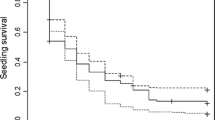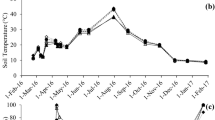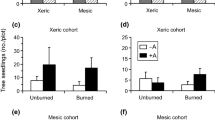Abstract
A seven-year study of marked plants and plots in Stipagrostis ciliata (Desf.) de Winter dune grassland, in the arid (<100 mm yr−1) Bushmanland area of the Northern Cape province of South Africa, was designed to test the hypothesis that establishment of ephemeral plants, and recruitment of perennial grasses was dependent upon disturbances that reduced the density of living perennial grass tussocks. In 1989, eight 4 m2 plots were cleared of perennial vegetation by uprooting and removing all plants so as to resemble small-scale disturbances made by burrowing mammals or territorial antelope. The vegetation on the cleared plots and surroundings was monitored until 1996. Initial results supported our hypothesis. In wet years, when ephemeral plants were abundant, their average fresh mass was 2–3 times greater per unit area on the cleared plots than in control plots in adjacent, undisturbed grassland. Many Stipagrostis seedlings established in the cleared plots over the two years following clearing but were rare in adjacent areas among established conspecifics. However, a drought in 1992 (11 mm of rain over 12 months) lead to widespread mortality of the perennial grass, killing 56% (range 22–79%) of established tufts. High densities of Stipagrostis seedlings appeared following the drought-breaking rains in January 1993, both in the disturbed plots and in the surrounding `undisturbed' dune grassland. Ephemeral plants established in large numbers throughout the area during the high rainfall year of 1996 and were generally more numerous in the old disturbances than in control plots. Seven years after clearing the biomass of grass on the cleared plots was approximately 34% of the mass removed from the plots in 1989 whereas in the undisturbed grassland biomass was 66% of 1989 levels. Drought had little long-term effect on community composition, and Stipagrostis ciliata constituted 94–98% of plant community before and after drought. Cleared plots were recolonised by S. ciliata, but the contribution of other grass species increased by 6–9%. Synchronous recruitment following occasional drought-induced mortality can generate even-aged populations of the dominant desert dune grasses.
Similar content being viewed by others
References
Aguilera, M. O. & Laurenroth, W. K. 1993. Seedling establishment in adult neighbourhoods -intraspecific constraints in the regeneration of the bunchgrass Bouteloua gracilis. J. Ecol. 81: 253–261.
Danckwerts, J. C. & Stuart-Hill, G. C. 1988. The effects of severe drought on the mortality and recovery of semi-arid grassveld. J. Grassl. Soc. South Afr. 5: 218–222.
Danin, A. & Orshan, G. 1995. Circular arrangement of Stipagrostis ciliata clumps in the Negev, Israel and near Gokaeb, Namibia. J. Arid. Environ. 29: 307–313.
Dean, W. R. J. & Milton, S. J 1991. Patch disturbances in arid grassy dunes: antelope, rodents and annual plants. J. Arid Environ. 20: 231–237.
Dean, W. R. J., Milton, S. J., Watkeys, M. K. & Hockey, P. A. R. 1991. Distribution, habitat preference and conservation status of the Red Lark Certhilauda burra in Cape Province, South Africa. Biol. Conserv. 58: 257–274.
Dean, W. R. J. & Macdonald, I. A. W. 1994. Historical changes in stocking rates of domestic livestock as a measure of semiarid and arid rangeland degradation in the Cape Province, South Africa. J. Arid Environ. 20: 231–237.
Defossé, G. E., Robberecht, R. & Bertilleer, M. B. 1997. Seedling dynamics of Festuca spp. in a grassland of Patagonia, Argentina, as affected by competition, microsites and grazing. J. Range Manag. 50: 73–79.
Desmet, P. G & Cowling, R. M. 1999. The climate of the Karoo -a functional approach. Pp. 3–16. In: Dean, W. R. J. & Milton, S. J. (eds). The Karoo, ecological patterns and processes. Cambridge University Press, Cambridge, U.K.
Dingle, R. V. & Hendy, Q. B. 1984. Late Mesozoic and Tertiary sediment supply to the eastern Cape Basin (S.E. Atlantic) and Palaeo-drainage systems in southwestern Africa. Marine Geol. 56: 13–26.
Fourie, J. H., De Wet, N. J. & Page, J. J. 1987. Veld condition and trend in Kalahari duneveld under an extensive stock production system. J. Grassl. Soc. of South Afr. 4: 48–54.
Grubb, P. J. 1988. The uncoupling of disturbance and recruitment, two kinds of seed bank, and persistence of plant population at the regional and local scales. Ann. Zool. Fennici 25: 23–36.
Günster, A. 1995. Grass cover distribution in the central Namib -a rapid method to assess regional and local rainfall patterns of arid regions? J. Arid. Environ. 29: 107–114.
Hobbs, R. J. & Mooney, H. A. 1991. Effects of rainfall variability and gopher disturbance on serpentine annual grassland dynamics. Ecology 72: 59–68.
Hoffman, M. T. 1996. Bushmanland Nama Karoo. P. 53. In: Low, A. B. & Rebelo, A. G. (eds) Vegetation of South Africa, Lesotho and Swaziland. Department of Environment Affairs and Tourism, Pretoria, South Africa.
Hoffman, M. T., Sonnenberg, D., Hurford, J. L. & Jagger, B. W. 1995. The ecology and management of Riemvasmaak's natural resources. National Botanical Institute, Claremont, South Africa.
Jeltsch, F., Milton, S. J., Dean, W. R. J. & van Rooyen, N. 1997. Simulated pattern formation around artificial waterholes in the semi-arid Kalahari. J. Veg. Sci. 8: 177–188.
Jeltsch, F., Wiegand, T. & Wissel, C. 1999. Spatially explicit computer simulation models -tools for understanding vegetation dynamics and supporting rangeland management. Pp. 231–241. In: Dean, W. R. J. & Milton, S. J. (eds). The Karoo, ecological patterns and processes. Cambridge University Press, Cambridge, U.K.
Knight, M. H. 1995. Drought-related mortality of wildlife in the southern Kalahari and the role of man. Afr. J. Ecol. 33: 377–394.
Laurenroth, W. K., Sala, O. E., Coffin, D. P. & Kirchner, T. B. 1994. The importance of soil water in the recruitment of Bouteloua gracilis in the shortgrass steppe. Ecol. Appl. 44: 741–749.
Lloyd, J. W. 1989. Discriminate analysis and ordination of vegetation and soils on the Vaalputs radioactive waste disposal sit, Bushmanland, South Africa. South Afr. J. Bot. 55: 127–136.
Milton, S. J. Dean, W. R. J. & Marincowitz, C. P. 1992. Preferential utilization of pans by springbok (Antidorcas marsupialis). J. Grassl. Soc. South Afr. 9: 114–118.
Milton, S. J. Dean, W. R. J., Marincowitz, C. P. & Kerley, G. I. H. 1995. Effects of the 1990/91 drought on rangeland in the Steytlerville Karoo. South Afr. J. Sci. 91: 78–84.
Moloney, K. A. 1990. Shifting demographic control of a perennial bunchgrass along a natural habitat gradient. Ecology 71: 1133–1143.
Novellie, P. A. & Bezuidenhout, H. 1994. The influence of rainfall and grazing on vegetation changes in the Mountain Zebra National Park. South Afr. J. Wildl. Res. 24: 60–71.
O'Connor, T. G. 1995. Transformation of a savanna grassland by drought and grazing. Afr. J. Range For. Sci. 12: 53–60.
O'Connor, T. G. 1996. Hierarchical control over seedling recruitment of the bunch-grass Themeda triandra in a semi-arid savanna. J. Appl. Ecol. 33: 1094–1106.
O'Connor, T. G. & Roux, P. W. 1995. Vegetation changes (1949-71) in a semi-arid, grassy, dwarf shrubland in the Karoo, South Africa -influence of rainfall and grazing by sheep. J. Appl. Ecol. 32: 612–626.
Palmer, A. V. & van Rooyen, A. F. 1998. Detecting vegetation change in the southern Kalahari using Landsat TM data. J. Arid Environ. 39: 143–154.
Perkins, J. S. & Thomas, D. S. G. 1993. Spreading deserts or spatially confined environmental impacts? Land Degrad. Rehab. 4: 179–194.
Schulze, E. D., Caldwell, M. M., Canadell, J., Mooney, H. A., Jackson, R. B., Parson, D., Scholes, R., Sala, O. E. & Trimbron, P. 1998. Downward flux of water through roots (i.e. inverse hydraulic lift) in dry Kalahari sands. Oecologia 115: 460–462.
Seely, M. K. 1978. Grassland productivity: the desert end of the curve. S. Afr. J. Sci. 74: 295–297.
Seely, M. K. 1990. Patterns of establishment on a linear desert dune. Isr. J. Bot. 39: 443–451.
Siegfried, W. R. 1988. Towards high-benefit and low-cost locusts. Pp. 2–26. In: McKenzie, B. and Longridge, M. (eds) Proceedings of the Locust Symposium. South African Institute of Ecologists Bulletin, Special Issue, Cape Town, South Africa.
Skinner, J. D. 1993. Springbok (Antidorcas marsupialis) treks. Trans. Roy. Soc. South Afr. 48: 291–305.
Southgate, R. I., Masters P. & Seely, M. K. 1996. Precipitation and biomass changes in the Namib dune ecosystem. J. Arid Environ. 33: 267–280.
Smith, C. A. 1966. Common names of South African Plants. Bot. Surv. Mem. 35. Botanical Research Institute, Pretoria, South Africa.
Van der Walt, P. T. & Le Riche, E. A. N. 1984. The influence of veld fire on an Acacia erioloba community in the Kalahari Gemsbok National Park. Koedoe 27: 103–106.
Van Rooyen, M. W. 1999. Functional aspects of short-lived plants. Pp. 107–122. In: Dean, W. R. J. & Milton, S. J. (eds). The Karoo, ecological patterns and processes. Cambridge University Press, Cambridge, U.K.
Van Rooyen, N., van Rensburg, D. J., Theron, G. K. & Bothma, J. du P. 1984. A preliminary report on the dynamics of the vegetation of the Kalahari Gemsbok National Park. Koedoe 27: 83–102.
Van Rooyen, N., Bredenkamp, G. J. & Theron, G. K. 1991. Kalahari vegetation: veld condition trends and ecological status of species. Koedoe 34: 61–72.
Watkeys, M. K. 1999. Soils of the arid south-western zone of Africa. Pp. 17–26. In: Dean, W. R. J. & Milton, S. J. (eds). The Karoo, ecological patterns and processes. Cambridge University Press, Cambridge, U.K.
Yeaton, R. I. 1988. Structure and function of the Namib dune grasslands, characteristics of the environmental gradients and species distributions. J. Ecol. 76: 744–758
Zucchini, W. & Adamson, P. T. 1984. The occurrence and severity of droughts in South Africa. Water Research Commission Report 91/1/84, Department of Water Affairs, Pretoria, South Africa.
Author information
Authors and Affiliations
Rights and permissions
About this article
Cite this article
Milton, S., Dean, W. Disturbance, drought and dynamics of desert dune grassland, South Africa. Plant Ecology 150, 37–51 (2000). https://doi.org/10.1023/A:1026585211708
Issue Date:
DOI: https://doi.org/10.1023/A:1026585211708




